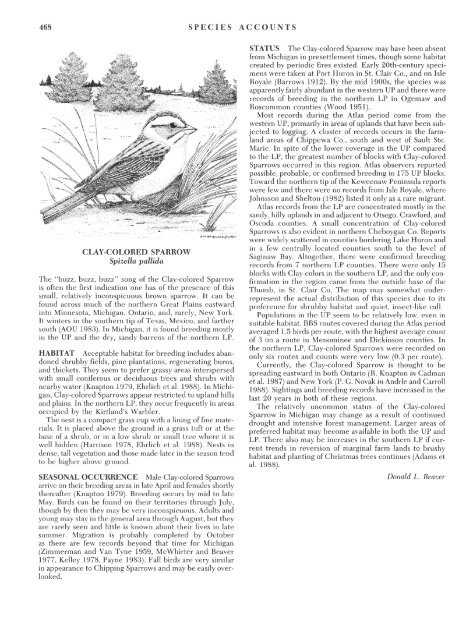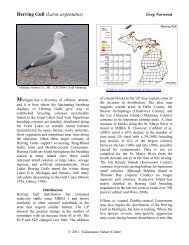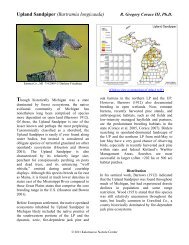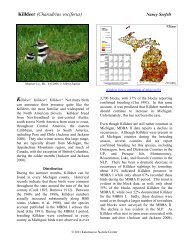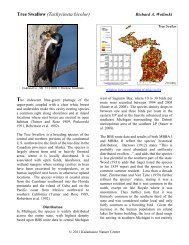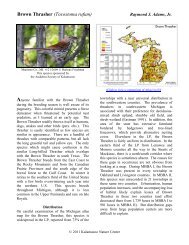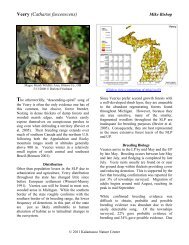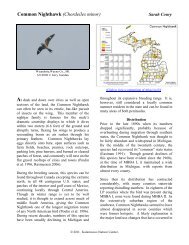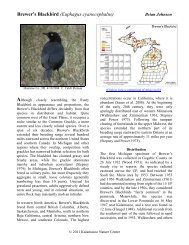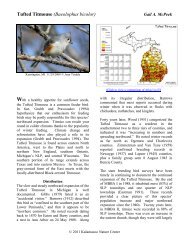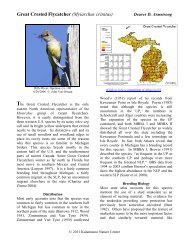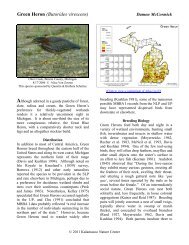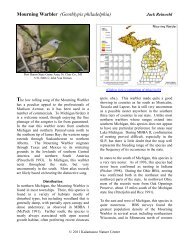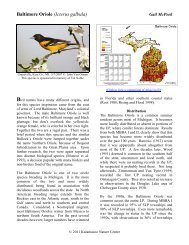Clay-colored Sparrow - Michigan Breeding Bird Atlas Website
Clay-colored Sparrow - Michigan Breeding Bird Atlas Website
Clay-colored Sparrow - Michigan Breeding Bird Atlas Website
You also want an ePaper? Increase the reach of your titles
YUMPU automatically turns print PDFs into web optimized ePapers that Google loves.
468 SPECIES ACCOUNTS<br />
CLAY-COLORED SPARROW<br />
Spizella pallida<br />
The "buzz, buzz, buzz" song of the <strong>Clay</strong>-<strong>colored</strong> <strong>Sparrow</strong><br />
is often the first indication one has of the presence of this<br />
small, relatively inconspicuous brown sparrow. It can be<br />
found across much of the northern Great Plains eastward<br />
into Minnesota, <strong>Michigan</strong>, Ontario, and, rarely, New York.<br />
It winters in the southern tip of Texas, Mexico, and farther<br />
south (AOU 1983). In <strong>Michigan</strong>, it is found breeding mostly<br />
in the UP and the dry, sandy barrens of the northern LP.<br />
HABITAT Acceptable habitat for breeding includes aban<br />
doned shrubby fields, pine plantations, regenerating burns,<br />
and thickets. They seem to prefer grassy areas interspersed<br />
with small coniferous or deciduous trees and shrubs with<br />
nearby water (Knapton 1979, Ehrlich et al. 1988). In Michi<br />
gan, <strong>Clay</strong>-<strong>colored</strong> <strong>Sparrow</strong>s appear restricted to upland hills<br />
and plains. In the northern LP, they occur frequently in areas<br />
occupied by the Kirtland's Warbler.<br />
The nest is a compact grass cup with a lining of fine mate<br />
rials. It is placed above the ground in a grass tuft or at the<br />
base of a shrub, or in a low shrub or small tree where it is<br />
well hidden (Harrison 1978, Ehrlich et al. 1988). Nests in<br />
dense, tall vegetation and those made later in the season tend<br />
to be higher above ground.<br />
SEASONAL OCCURRENCE Male <strong>Clay</strong>-<strong>colored</strong> <strong>Sparrow</strong>s<br />
arrive on their breeding areas in late April and females shortly<br />
thereafter (Knapton 1979). <strong>Breeding</strong> occurs by mid to late<br />
May. <strong>Bird</strong>s can be found on their territories through July,<br />
though by then they may be very inconspicuous. Adults and<br />
young may stay in the general area through August, but they<br />
are rarely seen and little is known about their lives in late<br />
summer. Migration is probably completed by October<br />
as there are few records beyond that time for <strong>Michigan</strong><br />
(Zimmerman and Van Tyne 1959, McWhirter and Beaver<br />
1977, Kelley 1978, Payne 1983). Fall birds are very similar<br />
in appearance to Chipping <strong>Sparrow</strong>s and may be easily over<br />
looked.<br />
STATUS The <strong>Clay</strong>-<strong>colored</strong> <strong>Sparrow</strong> may have been absent<br />
from <strong>Michigan</strong> in presettlement times, though some habitat<br />
created by periodic fires existed. Early 20th-century speci<br />
mens were taken at Port Huron in St. Clair Co., and on Isle<br />
Royale (Barrows 1912). By the mid 1900s, the species was<br />
apparently fairly abundant in the western UP and there were<br />
records of breeding in the northern LP in Ogemaw and<br />
Roscommon counties (Wood 1951).<br />
Most records during the <strong>Atlas</strong> period come from the<br />
western UP, primarily in areas of uplands that have been sub<br />
jected to logging. A cluster of records occurs in the farm<br />
land areas of Chippewa Co., south and west of Sault Ste.<br />
Marie. In spite of the lower coverage in the UP compared<br />
to the LP, the greatest number of blocks with <strong>Clay</strong>-<strong>colored</strong><br />
<strong>Sparrow</strong>s occurred in this region. <strong>Atlas</strong> observers reported<br />
possible, probable, or confirmed breeding in 175 UP blocks.<br />
Toward the northern tip of the Keweenaw Peninsula reports<br />
were few and there were no records from Isle Royale, where<br />
Johnsson and Shelton (1982) listed it only as a rare migrant.<br />
<strong>Atlas</strong> records from the LP are concentrated mostly in the<br />
sandy, hilly uplands in and adjacent to Otsego, Crawford, and<br />
Oscoda counties. A small concentration of <strong>Clay</strong>-<strong>colored</strong><br />
<strong>Sparrow</strong>s is also evident in northern Cheboygan Co. Reports<br />
were widely scattered in counties bordering Lake Huron and<br />
in a few centrally located counties south to the level of<br />
Saginaw Bay. Altogether, there were confirmed breeding<br />
records from 7 northern LP counties. There were only 15<br />
blocks with <strong>Clay</strong>-colors in the southern LP, and the only con<br />
firmation in the region came from the outside base of the<br />
Thumb, in St. Clair Co. The map may somewhat underrepresent<br />
the actual distribution of this species due to its<br />
preference for shrubby habitat and quiet, insect-like call.<br />
Populations in the UP seem to be relatively low, even in<br />
suitable habitat. BBS routes covered during the <strong>Atlas</strong> period<br />
averaged 1.5 birds per route, with the highest average count<br />
of 3 on a route in Menominee and Dickinson counties. In<br />
the northern LP, <strong>Clay</strong>-<strong>colored</strong> <strong>Sparrow</strong>s were recorded on<br />
only six routes and counts were very low (0.3 per route).<br />
Currently, the <strong>Clay</strong>-<strong>colored</strong> <strong>Sparrow</strong> is thought to be<br />
spreading eastward in both Ontario (R. Knapton in Cadman<br />
et al. 1987) and New York (P. G. Novak in Andrle and Carroll<br />
1988). Sightings and breeding records have increased in the<br />
last 20 years in both of these regions.<br />
The relatively uncommon status of the <strong>Clay</strong>-<strong>colored</strong><br />
<strong>Sparrow</strong> in <strong>Michigan</strong> may change as a result of continued<br />
drought and intensive forest management. Larger areas of<br />
preferred habitat may become available in both the UP and<br />
LP. There also may be increases in the southern LP if cur<br />
rent trends in reversion of marginal farm lands to brushy<br />
habitat and planting of Christmas trees continues (Adams et<br />
al. 1988).<br />
Donald L. Beaver
CLAY-COLORED SPARROW<br />
Possible<br />
Probable<br />
Confirmed<br />
PJON TOTAL S 143<br />
BREEDING EVIDENCE<br />
Number of townships reported<br />
UP<br />
87<br />
41<br />
15<br />
NLP<br />
53<br />
14<br />
9<br />
76<br />
SLP<br />
10<br />
3<br />
I<br />
14<br />
TOTALS<br />
Percentage of total townships<br />
150<br />
58<br />
25<br />
233<br />
23.4 12.9 2.0 12.3<br />
(of 610) (of 590) (of 696) (of 1896)<br />
Miles<br />
25<br />
40<br />
Kilometers


